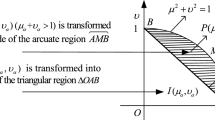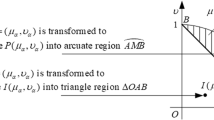Abstract
The main purpose of this paper is to unify intuitionistic fuzzy numbers (IFNs) into Pythagorean fuzzy numbers (PFNs) environment through the coordinate mapping, and establish a novel unified ranking method for some defects of sorting standards of the current popular IFNs and PFNs. The new score function or accuracy function cannot only overcome the defects of the existing methods, but also realize the overall ranking of PFNs by calculating the geometric area. In this paper, the internal relationship between Pythagorean fuzzy set (PFS) and PFN was first explained based on algebraic and geometric methods, and some defects in the current ranking criteria of IFNs and PFNs were pointed out through counterexamples. IFNs and PFNs were mapped to the point coordinates in the unit circle of the first quadrant by coordinate transformation. Second, under the Pythagorean fuzzy number environment, the new score function and accuracy function were proposed by calculating area of geometric region and geometric analysis, their rationality are proved by strict mathematical theory, and a new ranking criterion for PFNs is given. Finally, as an application example, some PFNs are randomly selected in the Pythagorean fuzzy environment, the superiority of the proposed method is illustrated by comparing with other three different ranking methods. The result shows that the proposed method not only overcomes the contradiction between the independent ranking of traditional IFNs and PFNs, but also the ranking results are more in line with the reality.




Similar content being viewed by others
Explore related subjects
Discover the latest articles and news from researchers in related subjects, suggested using machine learning.Data availability
The authors confirm that the data supporting the findings of this study are available within the article.
References
Akram M, Liyas F, Garg H (2021) ELECTRE-II method for group decision-making in Pythagorean fuzzy environment. Appl Intell 51(12):8701–8719
Atanassov K (1986) Intuitionistic fuzzy sets. Fuzzy Sets Syst 20(1):87–96
Chen SM, Tan JM (1994) Handling multicriteria fuzzy decision-making problems based on vague set theory. Fuzzy Sets Syst 67(2):163–172
Fei LG, Deng Y (2020) Multi-criteria decision making in Pythagorean fuzzy environment. Appl Intell 50(2):537–561
Firozja MA, Agheli B, Jamkhaneh EB (2020) A new similarity measure for Pythagorean fuzzy sets. Complex Intell Syst 6(1):67–74
Garg H (2017a) A new improved score function of an interval-valued Pythagorean fuzzy set based TOPSIS method. Int J Uncertain Quantif 7(5):463–474
Garg H (2017b) A novel improved accuracy function for interval valued Pythagorean fuzzy sets and its applications in decision making process. Int J Intell Syst 31(12):1247–1260
Garg H (2018) A linear programming method based on an improved score function for interval-valued Pythagorean fuzzy numbers and its application to decision-making. Int J Uncertain Fuzziness Knowl Based Syst 26(1):67–80
Hong DH, Choi CH (2000) Multicriteria fuzzy decision-making problems based on vague set theory. Fuzzy Sets Syst 114(1):103–113
Khan MSA, Abdullah S, Ali MY et al (2017) Pythagorean hesitant fuzzy sets and their application to group decision making with incomplete weight information. J Intell Fuzzy Syst 33:3971–3985
Khan MSA, Abdullah S, Ali MY et al (2018) Extension of TOPSIS method based on Choquet integral under interval-valued Pythagorean fuzzy environment. J Intell Fuzzy Syst 34:267–282
Li XP, Tao YJ, Li YH (2020) Decision making method for evaluating logistics companies based on the ordered representation of the polygonal fuzziness. J Intell Fuzzy Syst 9(3):3151–3166
Li XP, Li YH, Tao YJ (2021) Representation and aggregation of multi-source information of modern smart cities based on the intuitionistic polygonal fuzzy set. Int J Fuzzy Syst 23(4):967–983
Peng XD, Dai J (2017) Approaches to Pythagorean fuzzy stochastic multi-criteria decision making based on prospect theory and regret theory with new distance measure and score function. Int J Intell Syst 32(1):1187–1214
Peng XD, Ma XL (2020) Pythagorean fuzzy multi-criteria decision making method based on CODAS with new score function. J Intell Fuzzy Syst 38(3):3307–3318
Peng XD, Selvachandran G (2019) Pythagorean fuzzy set: state of the art and future directions. Artif Intell Rev 52:1873–1927
Peng XD, Yang Y (2015) Some results for Pythagorean fuzzy sets. Int J Intell Syst 30(11):1133–1160
Peng XD, Dai J, Garg H (2018) Exponential operation and aggregation operator for q-rung orthopair fuzzy set and their decision-making method with a new score function. Int J Intell Syst 33(11):2255–2282
Rahman K, Abdullah S, Ahmad R (2017a) Pythagorean fuzzy Einstein geometric operators and their application to multiple attribute decision making. J Intell Fuzzy Syst 33:635–647
Rahman K, Khan MSA, Abdullah S, Hussain F (2017b) Some properties of Pythagorean fuzzy hybrid averaging aggregation operator. J Appl Environ Biol Sci 7:122–133
Rahman K, Khan MSA, Ullah M, Fahmi A (2017c) Multiple attribute group decision making for plant location selection with Pythagorean fuzzy weighted geometric aggregation operator. Nucleus 54:66–74
Sun G, Li XP, Chen DG (2022a) Ranking defects and solving countermeasures for Pythagorean fuzzy sets with hesitant degree. Int J Mach Learn Cybern 13(5):1265–1281
Sun G, Wang MX, Li XP (2022b) Centroid coordinate ranking of Pythagorean fuzzy numbers and its application in group decision making. Cogn Comput 14(2):602–623
Ullah K, Mahmood, Ali Z et al (2020) On some distance measures of complex Pythagorean fuzzy sets and their applications in pattern recognition. Complex Intell Syst 6(1):15–27
Wang GJ, Duan Y (2018) TOPSIS approach for multi-attribute decision making problems based on n-intuitionistic polygonal fuzzy sets description. Comput Ind Eng 124(10):573–581
Wang GJ, Tao YJ, Li YH (2020) TOPSIS evaluation system of logistics transportation based on an ordered representation of the polygonal fuzzy set. Int J Fuzzy Syst 22(5):1565–1581
Yager RR (2013) Pythagorean fuzzy subsets. In: Proceeding joint IFSA World Congress and NAFIPS annual meeting, Edmonton, Canada, pp 57–61
Yager RR (2014) Pythagorean membership grades in multicriteria decision making. IEEE Trans Fuzzy Syst 22(4):958–965
Zhang XL (2016) Multicriteria Pythagorean fuzzy decision analysis: a hierarchical QUALIFLEX approach with the closeness index-based ranking methods. Inf Sci 33(1):104–124
Zhang XL, Xu ZS (2014) Extension of TOPSIS to multiple criteria decision making with Pythagorean fuzzy sets. Int J Intell Syst 29(12):1061–1078
Author information
Authors and Affiliations
Corresponding author
Ethics declarations
Conflict of interest
The authors declare that they have no conflict of interest.
Ethical approval
This article does not contain any studies with human participants or animals performed by any of the authors.
Informed consent
The informed consent was obtained from all individual participants included in the study.
Additional information
Communicated by Susana Montes.
Publisher's Note
Springer Nature remains neutral with regard to jurisdictional claims in published maps and institutional affiliations.
This work has been supported by National Natural Science Foundation of China (Grant no. 61463019) and Natural Science Foundation of Hunan Province (Grant no. 2019JJ40062).
Rights and permissions
Springer Nature or its licensor (e.g. a society or other partner) holds exclusive rights to this article under a publishing agreement with the author(s) or other rightsholder(s); author self-archiving of the accepted manuscript version of this article is solely governed by the terms of such publishing agreement and applicable law.
About this article
Cite this article
Li, Y., Sun, G. A unified ranking method of intuitionistic fuzzy numbers and Pythagorean fuzzy numbers based on geometric area characterization. Comp. Appl. Math. 42, 16 (2023). https://doi.org/10.1007/s40314-022-02153-1
Received:
Revised:
Accepted:
Published:
DOI: https://doi.org/10.1007/s40314-022-02153-1
Keywords
- Intuitionistic fuzzy number (IFN)
- Pythagorean fuzzy number (PFN)
- Area of geometric region
- Score function
- Accuracy function
- Unified ranking




